▼
Tuesday, July 25, 2006
A long blogging break!
Just a quick note to say...I am going on an extended blogging hiatus. I need to focus on my work 100% as I finish up my dissertation and get ready to defend my doctoral thesis. I know I will be lurking at my favorite blogs whenever I need a break though :) Wishing everyone the very best until I get back in a few months!
Monday, July 24, 2006
Flour Power!
It is almost time for yet another edition of the foodie event Jihva for ingredients, an original concept of Indira from Mahanandi and hosted this month by Santhi of Santhi's kitchen. Following closely on the heels of last month's theme of lentils or dals, this time Santhi has chosen the ingredient Flour!
I took a peek into my kitchen cupboards and counted the flours I have on hand; here is what I found...
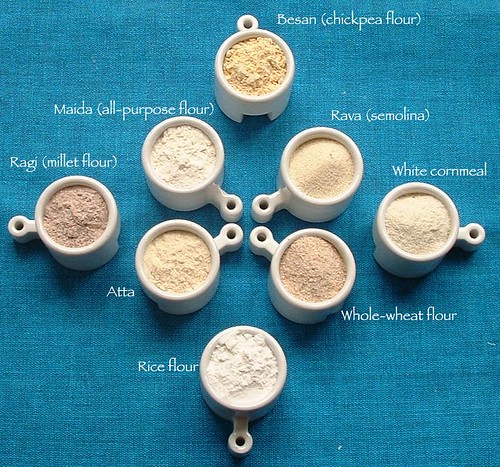
It turns out, that like most Indian kitchens, I keep a variety of flours on hand, and they can be basically divided into wheat flours (the four in the middle, listed below from the finest to the coarsest) and flours from other grains or pulses (the four on the outside). Here is what I generally use them for...
The wheat flours:
1. All-purpose flour or maida: I use this for baked goods like cakes or muffins, pizza dough and for making bechamel (white) sauce. Some Indian flatbreads such as bhaturas also call for all-purpose flour. This ultra-refined flour, however, is not the healthiest option (it has most of the nutrients and fiber milled out of it), and I try and keep my use of it to a minimum.
2. Atta: This is the Indian-style whole-wheat flour. It is a finer texture compared to the whole-wheat flour found in American supermarkets. I use this for Indian breads like stuffed parathas and regular rotis or chapatis.
3. Whole-wheat flour: This is something I keep on hand for making whole-wheat pizza dough, which calls for a mixture of all-purpose and whole-wheat flour. Pizza made with whole-wheat dough looks and tastes delicious, in addition to being better for you.
4. Semolina or sooji or rava: This is the coarsest wheat flour, sold most often in American supermarkets under the brand "cream of wheat". I use it for making upma, a delicious risotto-like Indian breakfast, and also use it in smaller quantities as (a) an addition to some batters for a crispier result and (b) as a substitute for breadcrumbs for dipping patties in, prior to shallow-frying them.
Other flours:
5. Millet or ragi flour: This makes delicious and nutritious pancakes.
6. Rice flour: Also kept on hand for making quick breakfast pancakes.
7. Cornmeal: I use this for a delicious zucchini cornbread that pairs beautifully with some spicy chili.
8. Chickpea flour or besan: My favorite flour! I use it to make batter for fritters (bhajiyas and pakodas), and to make my beloved stew, pithale. This flour also makes delicious vegan "omelets" for breakfast.
For my entry today, I was faced with too many choices! After much agonised and back-and-forth-ing, I decided to go back to basics and make a traditional feast of puri with aamras and batata bhaji where puri= fried bread, aamras= mango puree and batata bhaji= a dry spicy potato dish. This combination is often served at special occasions in Marathi homes, and it was a natural choice for me because (a) I had never made puris before, and wanted to try my hand at this classic "special" bread and (b) I had a tin of canned mango puree from my parents' backyard (all-natural, with no added sweeteners) and puris are just special enough for this precious mango to be eaten with. The puri recipe was really simple, pieced together from a few recipes I found on the internet. The dough contains atta, a dab of oil and a sprinkle of salt. I did add some semolina (rava) to make the puris crisper. The result was wonderful: the puris were exactly as I hoped for (even with my imperfectly shaped circles). The meal consisted of alternate dips of the hot puffy puris into chilled mango and spicy potato...absolutely heavenly!
Puri
(serves 2-3)
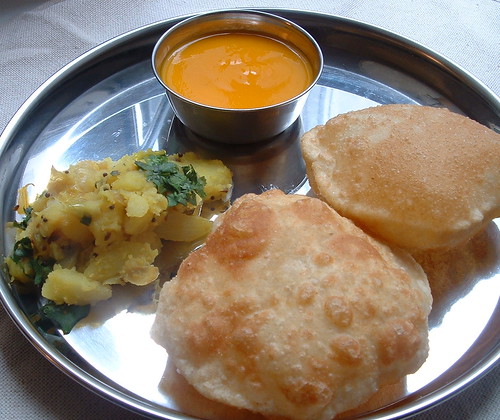
Ingredients:
2 cups atta (Indian-style whole-wheat flour)
1 heaped tbsp semolina (rava)
1/2 tsp salt
1 tsp oil
oil for deep frying
Method:
Mix all the ingredients in a large bowl. Add warm water little by little to make a smooth but *firm* dough (firmer than regular roti dough). Let the dough relax for 30 minutes under a barely-damp towel in the covered bowl. Then take about a tablespoon of dough at a time, roll it into a thin circle (using some more atta to help in the rolling process), and deep fry for a few seconds on each side until the puri is puffed and golden. Drain well on some paper towels and serve hot.
Someone requested the recipe for the potato, so here it is:
Batata Bhaji
(serves 2-3)
Ingredients:
3 large or 4 medium potatoes
1 onion, sliced
2 chillies, chopped fine
5-6 curry leaves
pinch of asafoetida
1 tsp mustard seeds
1 tsp cumin seeds
1 tsp coriander powder
1 tsp cumin powder
1/2 tsp turmeric
salt to taste
1 tsp oil
1 wedge of lemon
2 tbsp cilantro, minced
Method:
1. Boil the potatoes. When they are cool enough to handle, peel them and chop into cubes.
2. Heat oil in a pan. Temper with cumin and mustard seeds.
3. Add the onion, chillies, asafoetida and curry leaves and saute till onions are lightly browned.
4. Add the salt and turmeric powder and stir to mix.
5. Add the potato cubes and stir well. Cover and cook for 5 minutes.
6. Turn off the heat. Sprinkle with lemon juice and cilantro. Serve with puris.
I took a peek into my kitchen cupboards and counted the flours I have on hand; here is what I found...

It turns out, that like most Indian kitchens, I keep a variety of flours on hand, and they can be basically divided into wheat flours (the four in the middle, listed below from the finest to the coarsest) and flours from other grains or pulses (the four on the outside). Here is what I generally use them for...
The wheat flours:
1. All-purpose flour or maida: I use this for baked goods like cakes or muffins, pizza dough and for making bechamel (white) sauce. Some Indian flatbreads such as bhaturas also call for all-purpose flour. This ultra-refined flour, however, is not the healthiest option (it has most of the nutrients and fiber milled out of it), and I try and keep my use of it to a minimum.
2. Atta: This is the Indian-style whole-wheat flour. It is a finer texture compared to the whole-wheat flour found in American supermarkets. I use this for Indian breads like stuffed parathas and regular rotis or chapatis.
3. Whole-wheat flour: This is something I keep on hand for making whole-wheat pizza dough, which calls for a mixture of all-purpose and whole-wheat flour. Pizza made with whole-wheat dough looks and tastes delicious, in addition to being better for you.
4. Semolina or sooji or rava: This is the coarsest wheat flour, sold most often in American supermarkets under the brand "cream of wheat". I use it for making upma, a delicious risotto-like Indian breakfast, and also use it in smaller quantities as (a) an addition to some batters for a crispier result and (b) as a substitute for breadcrumbs for dipping patties in, prior to shallow-frying them.
Other flours:
5. Millet or ragi flour: This makes delicious and nutritious pancakes.
6. Rice flour: Also kept on hand for making quick breakfast pancakes.
7. Cornmeal: I use this for a delicious zucchini cornbread that pairs beautifully with some spicy chili.
8. Chickpea flour or besan: My favorite flour! I use it to make batter for fritters (bhajiyas and pakodas), and to make my beloved stew, pithale. This flour also makes delicious vegan "omelets" for breakfast.
For my entry today, I was faced with too many choices! After much agonised and back-and-forth-ing, I decided to go back to basics and make a traditional feast of puri with aamras and batata bhaji where puri= fried bread, aamras= mango puree and batata bhaji= a dry spicy potato dish. This combination is often served at special occasions in Marathi homes, and it was a natural choice for me because (a) I had never made puris before, and wanted to try my hand at this classic "special" bread and (b) I had a tin of canned mango puree from my parents' backyard (all-natural, with no added sweeteners) and puris are just special enough for this precious mango to be eaten with. The puri recipe was really simple, pieced together from a few recipes I found on the internet. The dough contains atta, a dab of oil and a sprinkle of salt. I did add some semolina (rava) to make the puris crisper. The result was wonderful: the puris were exactly as I hoped for (even with my imperfectly shaped circles). The meal consisted of alternate dips of the hot puffy puris into chilled mango and spicy potato...absolutely heavenly!
Puri
(serves 2-3)

Ingredients:
2 cups atta (Indian-style whole-wheat flour)
1 heaped tbsp semolina (rava)
1/2 tsp salt
1 tsp oil
oil for deep frying
Method:
Mix all the ingredients in a large bowl. Add warm water little by little to make a smooth but *firm* dough (firmer than regular roti dough). Let the dough relax for 30 minutes under a barely-damp towel in the covered bowl. Then take about a tablespoon of dough at a time, roll it into a thin circle (using some more atta to help in the rolling process), and deep fry for a few seconds on each side until the puri is puffed and golden. Drain well on some paper towels and serve hot.
Someone requested the recipe for the potato, so here it is:
Batata Bhaji
(serves 2-3)
Ingredients:
3 large or 4 medium potatoes
1 onion, sliced
2 chillies, chopped fine
5-6 curry leaves
pinch of asafoetida
1 tsp mustard seeds
1 tsp cumin seeds
1 tsp coriander powder
1 tsp cumin powder
1/2 tsp turmeric
salt to taste
1 tsp oil
1 wedge of lemon
2 tbsp cilantro, minced
Method:
1. Boil the potatoes. When they are cool enough to handle, peel them and chop into cubes.
2. Heat oil in a pan. Temper with cumin and mustard seeds.
3. Add the onion, chillies, asafoetida and curry leaves and saute till onions are lightly browned.
4. Add the salt and turmeric powder and stir to mix.
5. Add the potato cubes and stir well. Cover and cook for 5 minutes.
6. Turn off the heat. Sprinkle with lemon juice and cilantro. Serve with puris.
Saturday, July 22, 2006
Recipe Watch 3, from my *tiny* kitchen...
Far more than cookbooks, I use my fellow bloggers as inspiration to try some new recipes and find new favorites. Every so often, a recipe from a food blog will make it to our hit-list, and go into routine circulation on our dinner menu. Here are some of my recent "finds":
1. My introduction to chard: I love eating my greens. Always have. Eating in the cafeteria in my hostel in college, I was the one person who would enthusiastically eat up the weekly serving of mystery-greens-in-a-mush (Am I right, M?). However, cooking with greens is another story: anything other than the familiar spinach intimidates me. So was it with chard. Those huge stalks and oversize leaves...what do you make with it? I jumped for joy when Barbara of Tigers and Strawberries posted her recipe for vegetarian enchiladas. The filling called for chard, corn and black beans. I followed Barbara's recipe for the filling, but used store-bought corn tortillas and my favorite tried-and-tested salsa verde recipe for the sauce. The result was wonderful: the chard tasted fresh and "green" without being bitter or overwhelming. Overall, the enchiladas were so tasty and healthy! The amounts suggested in the recipe made two whole dinners for V and me. I am dying to try chard in more dishes, so let me know if you have a suggestion.
2. One of every two nights, dinner at my home is some-form-of-rice with some-form-of-beans, and I am constantly looking for fresh ideas for cooking dal or beans. One recipe from Shammi's Food-In the Main caught my eye: it used one of my favorite beans- black-eyed peas. Shammi's black-eyes peas in yogurt sauce was easy to make, looked pretty and tasted sublime. Like all of Shammi's recipes that I have tried so far!
3. The next two dal dishes come from Sailu's excellent round-up of the foodie event "Jihva for Ingredients 3". Dozens of bloggers churned out some inspiring (and inspired) dishes using lentils, and I have my eye on trying on most of them. The first recipe I tried was from the host, Sailu, herself. I am always looking for good recipes for classic dishes, and dal makhani (translated as buttery lentils) is probably the the best example of a stereotyped classic Indian entree. Sailu's recipe for dal makhani was an instant hit: with the combination of lentils and kidney beans, a rich creamy sauce of tomatoes, onion, subtle spices, anointed with butter and cream; this dish is enough to make any dinner special!
4. This is the other hit from the dal round-up: I seem to be on a chana dal binge, and the dalcha recipe from Nabeela of Trial and Error looked intriguing and tempting. Since summer squash is in season right now, I used some beautiful yellow squash in place of the gourd in the dalcha recipe. I served the dalcha with rice that had caramelized onions stirred into it. The result was terrific!
5. To end this round-up, a simple and tasty dish from Gini-Ann of Salt and Pepper: a radish pachadi or yogurt relish that is perfect for summer. Gini, who has a green thumb indeed, used beautiful radishes from her own garden, while I had to resign myself to radishes grown by someone else (in new jersey, though, so it was close to home). This whole summer, I have been buying radishes almost every week: to be used in a simple mixed salad, or to be added to sambar, an idea I first got from Indira of Mahanandi. Gini's recipe is now another favorite: radishes (with some radish greens) sauteed lightly to bring out their sweetness, then dressed with a tempered yogurt sauce. Absolutely divine!
Finally, some of you were interested in taking a look at my *tiny* kitchen, where all the food on One Hot Stove gets made. Here it is:

The kitchen has been carved out of the niche that is the coat closet in normal (which is to say, non-NYC) apartments. So, to the right of this photo is the front door, and to the left is the living room. The kitchen contains three electric burners (two of which work), a small oven (good thing I never have to roast turkeys), and the only counter space is that between the knife rack and the dish drainer. Whenever I try to use a rolling pin in this counter space, I have to hold it at the diagonal across the space, otherwise I either hit the wall or knock the dish tray on the floor! Across from this niche is a wall which hold a little spice rack, and that is the sum total of my kitchen (fridge, toaster oven and microwave are scattered in the living room).
I happen to love this kitchen, though, and I have been cooking meals for 20 people here for years. If there is anyone out there who complains that they don't cook because their kitchen is too small, y'all know it is just an excuse :) !!
In a few months, I will be moving to another city and a bigger kitchen where I can hold my rolling pin any damn way I please, and I won't lie to you: I'm excited about that :)
1. My introduction to chard: I love eating my greens. Always have. Eating in the cafeteria in my hostel in college, I was the one person who would enthusiastically eat up the weekly serving of mystery-greens-in-a-mush (Am I right, M?). However, cooking with greens is another story: anything other than the familiar spinach intimidates me. So was it with chard. Those huge stalks and oversize leaves...what do you make with it? I jumped for joy when Barbara of Tigers and Strawberries posted her recipe for vegetarian enchiladas. The filling called for chard, corn and black beans. I followed Barbara's recipe for the filling, but used store-bought corn tortillas and my favorite tried-and-tested salsa verde recipe for the sauce. The result was wonderful: the chard tasted fresh and "green" without being bitter or overwhelming. Overall, the enchiladas were so tasty and healthy! The amounts suggested in the recipe made two whole dinners for V and me. I am dying to try chard in more dishes, so let me know if you have a suggestion.
2. One of every two nights, dinner at my home is some-form-of-rice with some-form-of-beans, and I am constantly looking for fresh ideas for cooking dal or beans. One recipe from Shammi's Food-In the Main caught my eye: it used one of my favorite beans- black-eyed peas. Shammi's black-eyes peas in yogurt sauce was easy to make, looked pretty and tasted sublime. Like all of Shammi's recipes that I have tried so far!
3. The next two dal dishes come from Sailu's excellent round-up of the foodie event "Jihva for Ingredients 3". Dozens of bloggers churned out some inspiring (and inspired) dishes using lentils, and I have my eye on trying on most of them. The first recipe I tried was from the host, Sailu, herself. I am always looking for good recipes for classic dishes, and dal makhani (translated as buttery lentils) is probably the the best example of a stereotyped classic Indian entree. Sailu's recipe for dal makhani was an instant hit: with the combination of lentils and kidney beans, a rich creamy sauce of tomatoes, onion, subtle spices, anointed with butter and cream; this dish is enough to make any dinner special!
4. This is the other hit from the dal round-up: I seem to be on a chana dal binge, and the dalcha recipe from Nabeela of Trial and Error looked intriguing and tempting. Since summer squash is in season right now, I used some beautiful yellow squash in place of the gourd in the dalcha recipe. I served the dalcha with rice that had caramelized onions stirred into it. The result was terrific!
5. To end this round-up, a simple and tasty dish from Gini-Ann of Salt and Pepper: a radish pachadi or yogurt relish that is perfect for summer. Gini, who has a green thumb indeed, used beautiful radishes from her own garden, while I had to resign myself to radishes grown by someone else (in new jersey, though, so it was close to home). This whole summer, I have been buying radishes almost every week: to be used in a simple mixed salad, or to be added to sambar, an idea I first got from Indira of Mahanandi. Gini's recipe is now another favorite: radishes (with some radish greens) sauteed lightly to bring out their sweetness, then dressed with a tempered yogurt sauce. Absolutely divine!
Finally, some of you were interested in taking a look at my *tiny* kitchen, where all the food on One Hot Stove gets made. Here it is:

The kitchen has been carved out of the niche that is the coat closet in normal (which is to say, non-NYC) apartments. So, to the right of this photo is the front door, and to the left is the living room. The kitchen contains three electric burners (two of which work), a small oven (good thing I never have to roast turkeys), and the only counter space is that between the knife rack and the dish drainer. Whenever I try to use a rolling pin in this counter space, I have to hold it at the diagonal across the space, otherwise I either hit the wall or knock the dish tray on the floor! Across from this niche is a wall which hold a little spice rack, and that is the sum total of my kitchen (fridge, toaster oven and microwave are scattered in the living room).
I happen to love this kitchen, though, and I have been cooking meals for 20 people here for years. If there is anyone out there who complains that they don't cook because their kitchen is too small, y'all know it is just an excuse :) !!
In a few months, I will be moving to another city and a bigger kitchen where I can hold my rolling pin any damn way I please, and I won't lie to you: I'm excited about that :)
Sunday, July 16, 2006
Books and Food: Freedom Song by Amit Chaudhuri
This article is part of a special series called "Books and Food". I have loved books long before I ever got interested in the culinary arts. Short stories, novels, biographies and travelogues, I love them all. Human life is inextricably linked to food, and books often use descriptions of feasts and famines, dinner rituals and food memories to bring a point across to the reader. In this series, I talk about my favorite books and the food passages therein, and make a dish or a meal inspired by the book
Today's book: A Strange and Sublime Address, a novella by Amit Chaudhuri, part of the book Freedom Song
The food: A Bengali meal of Chholar Dal and Aloo Posto, served over steamed rice

Amit Chaudhuri's novella A Strange and Sublime Address is part of a collection of three novellas, Freedom Song. It is a story with a plot that is remarkable by its non-existence! It is not a story so much as it is a snapshot, a description of a certain time and place, capturing the minutae of existence of a certain family. Sandeep visits his mother's family in Calcutta for the summer, and Chaudhuri captures this simple summer vacation- the day-today activities of Sandeep and his two boy cousins, the goings-about of the typical Bengali household- with his exquisitely descriptive language. Here is a book that reads like a poem.
"...Later, they went down to have lunch in the dining-room; they dangled their feet ferociously from chairs round a large, shabby table with pots thronging in the centre.
Pieces of boal fish, cooked in turmeric, red chilli paste, onions and garlic, lay in a red, fiery sauce in a red pan; rice, packed into an even white cake, had a spade-like spoon embedded in it; slices of fried aubergine were arranged on a white dish; dal was served from another pan with a dropping ladle; long, complex filaments of banana-flower, exotic, botanical, lay in yet another pan in a dark sauce; each plate had a heap of salt on one side, a green chilli, and a slice of sweet-smelling lemon. The grown-ups snapped the chillies (each made a sounds terse as a satirical retort), and scattered the tiny, deadly seeds in their food. If any of the boys were ever brave or foolish enough to bite a chilli, their eyes filled tragically with tears, and they longed to drown in a cool, clear lake. Though Chhotomama was far from affluent, they ate well, especially on Sundays, caressing the rice and sauces on their plates with attentive, sensuous fingers. fingers which performed a practised and graceful ballet on the plate till it was quite empty"
I am a newcomer to Bengali cuisine. Bengali food is stereotyped by the heavy consumption of rice and fish, and is famous for its delicious milk-based sweets. Vegetarian Bengali food is traditionally "satvik", meaning "pure" and devoid of onions and garlic. Unlike the vegetarian food of the rest of India, Bengali veggie food is very mild as far as spices go. To make a simple home-style Bengali-inspired meal, I decided to make two classics: a simple chana dal called chholaar dal, a potato-and-poppy seed preparation called aloo posto and some piping hot steamed rice to round out the meal.
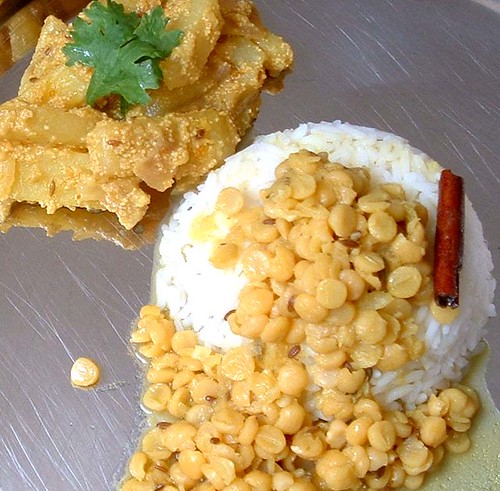
The chholar dal recipe is kindly provided by my friend Sujayita. She served this at a dinner to me once, and I was delighted by this mild, sweetish, buttery tasting dal. I personally tend to not use chana dal very much, and when I tasted this dal, I was convinced that I should use it more.
Chholaar Dal
(serves 4)
Ingredients:
1 cup chana dal (split gram lentils)
1 heaped tbsp grated fresh ginger
Tempering:
1 tbsp oil
1 tbsp ghee
2 bay leaves
1 tsp cumin seeds
1/2 tsp fennel seeds
1 inch piece of cinnamon
Seasoning:
1/2 tsp turmeric
1 heaped tsp sugar (or to taste)
salt to taste
Garnish:
Bits of coconut, fried (optional)
Method
1. Soak the chana dal for 8-10 hours. Then cook on stove-top or in pressure cooker until it is tender but not mushy.
2. Stir the ginger into the cooked dal and set aside.
3. Heat the oil and ghee, then add all the tempering ingredients. Saute for a couple of minutes.
4. Add the turmeric and saute for a few seconds, then add cooked dal and simmer for 5 minutes.
5. Season with salt and sugar. You can add more water if the dal appears too thick. Garnish with coconut, if using.
The aloo posto recipe originates with my aunt J who lives in Toronto. Although she is Konkani, she was raised in Calcutta and is married to a Bengali; traditional Bengali food often makes its way to her table. When I visited her three years ago, she delighted me by serving aloo posto with typical Konkani-style dal, a true marriage of two culinary traditions! Once I returned home, I tried making it and it came out great. However, in a moment of culinary bravado, I neglected to write the recipe down. This is the best I can remember of it, so I'm not making any claims to authenticity with this recipe!
Aloo Posto
(serves 4)
Ingredients
2 large or 3 medium potatoes
salt to taste
1/2 tsp turmeric
2 tbsp oil
1 tsp cumin seeds
1 bayleaf
1/2 cup poppy seeds
2 green or red chillies
Method
1. Soak the poppy seeds for 30 minutes. Grind them with the chillies, using very little water, to make a thick paste.
2. Peel the potatoes and slice them into thick stubby finger shapes. Rub them with salt and turmeric and set aside.
3. Heat the oil, then saute the cumin seeds and bayleaf for a minute.
4. Add the potatoes and saute for a few minutes.
5. Stir in the poppy seed paste and 1/2 cup water.
6. Cover and cook till potatoes are tender and well-coated with the paste (adding a little more water if the potatoes start sticking to the pan).
See you soon with a new edition of "Recipe Watch", where I describe some recipes from my fellow bloggers that I have tried and loved. Have a great week ahead!
Today's book: A Strange and Sublime Address, a novella by Amit Chaudhuri, part of the book Freedom Song
The food: A Bengali meal of Chholar Dal and Aloo Posto, served over steamed rice

Amit Chaudhuri's novella A Strange and Sublime Address is part of a collection of three novellas, Freedom Song. It is a story with a plot that is remarkable by its non-existence! It is not a story so much as it is a snapshot, a description of a certain time and place, capturing the minutae of existence of a certain family. Sandeep visits his mother's family in Calcutta for the summer, and Chaudhuri captures this simple summer vacation- the day-today activities of Sandeep and his two boy cousins, the goings-about of the typical Bengali household- with his exquisitely descriptive language. Here is a book that reads like a poem.
"...Later, they went down to have lunch in the dining-room; they dangled their feet ferociously from chairs round a large, shabby table with pots thronging in the centre.
Pieces of boal fish, cooked in turmeric, red chilli paste, onions and garlic, lay in a red, fiery sauce in a red pan; rice, packed into an even white cake, had a spade-like spoon embedded in it; slices of fried aubergine were arranged on a white dish; dal was served from another pan with a dropping ladle; long, complex filaments of banana-flower, exotic, botanical, lay in yet another pan in a dark sauce; each plate had a heap of salt on one side, a green chilli, and a slice of sweet-smelling lemon. The grown-ups snapped the chillies (each made a sounds terse as a satirical retort), and scattered the tiny, deadly seeds in their food. If any of the boys were ever brave or foolish enough to bite a chilli, their eyes filled tragically with tears, and they longed to drown in a cool, clear lake. Though Chhotomama was far from affluent, they ate well, especially on Sundays, caressing the rice and sauces on their plates with attentive, sensuous fingers. fingers which performed a practised and graceful ballet on the plate till it was quite empty"
I am a newcomer to Bengali cuisine. Bengali food is stereotyped by the heavy consumption of rice and fish, and is famous for its delicious milk-based sweets. Vegetarian Bengali food is traditionally "satvik", meaning "pure" and devoid of onions and garlic. Unlike the vegetarian food of the rest of India, Bengali veggie food is very mild as far as spices go. To make a simple home-style Bengali-inspired meal, I decided to make two classics: a simple chana dal called chholaar dal, a potato-and-poppy seed preparation called aloo posto and some piping hot steamed rice to round out the meal.

The chholar dal recipe is kindly provided by my friend Sujayita. She served this at a dinner to me once, and I was delighted by this mild, sweetish, buttery tasting dal. I personally tend to not use chana dal very much, and when I tasted this dal, I was convinced that I should use it more.
Chholaar Dal
(serves 4)
Ingredients:
1 cup chana dal (split gram lentils)
1 heaped tbsp grated fresh ginger
Tempering:
1 tbsp oil
1 tbsp ghee
2 bay leaves
1 tsp cumin seeds
1/2 tsp fennel seeds
1 inch piece of cinnamon
Seasoning:
1/2 tsp turmeric
1 heaped tsp sugar (or to taste)
salt to taste
Garnish:
Bits of coconut, fried (optional)
Method
1. Soak the chana dal for 8-10 hours. Then cook on stove-top or in pressure cooker until it is tender but not mushy.
2. Stir the ginger into the cooked dal and set aside.
3. Heat the oil and ghee, then add all the tempering ingredients. Saute for a couple of minutes.
4. Add the turmeric and saute for a few seconds, then add cooked dal and simmer for 5 minutes.
5. Season with salt and sugar. You can add more water if the dal appears too thick. Garnish with coconut, if using.
The aloo posto recipe originates with my aunt J who lives in Toronto. Although she is Konkani, she was raised in Calcutta and is married to a Bengali; traditional Bengali food often makes its way to her table. When I visited her three years ago, she delighted me by serving aloo posto with typical Konkani-style dal, a true marriage of two culinary traditions! Once I returned home, I tried making it and it came out great. However, in a moment of culinary bravado, I neglected to write the recipe down. This is the best I can remember of it, so I'm not making any claims to authenticity with this recipe!
Aloo Posto
(serves 4)
Ingredients
2 large or 3 medium potatoes
salt to taste
1/2 tsp turmeric
2 tbsp oil
1 tsp cumin seeds
1 bayleaf
1/2 cup poppy seeds
2 green or red chillies
Method
1. Soak the poppy seeds for 30 minutes. Grind them with the chillies, using very little water, to make a thick paste.
2. Peel the potatoes and slice them into thick stubby finger shapes. Rub them with salt and turmeric and set aside.
3. Heat the oil, then saute the cumin seeds and bayleaf for a minute.
4. Add the potatoes and saute for a few minutes.
5. Stir in the poppy seed paste and 1/2 cup water.
6. Cover and cook till potatoes are tender and well-coated with the paste (adding a little more water if the potatoes start sticking to the pan).
See you soon with a new edition of "Recipe Watch", where I describe some recipes from my fellow bloggers that I have tried and loved. Have a great week ahead!
Thursday, July 13, 2006
Test-Driving my new Le Creuset
Early this year, I made a resolution to stock my kitchen with better cookware. One of the items high on my list was a heavy-duty cast-iron casserole. A few weeks ago, my friend Laureen stopped by, and came bearing a wedding gift in a big old heavy box. She must be a mind-reader, because that box contained my object of desire: a le creuset casserole, in the cutest yellow-tomato shape (complete with a realistic stem-like lid). 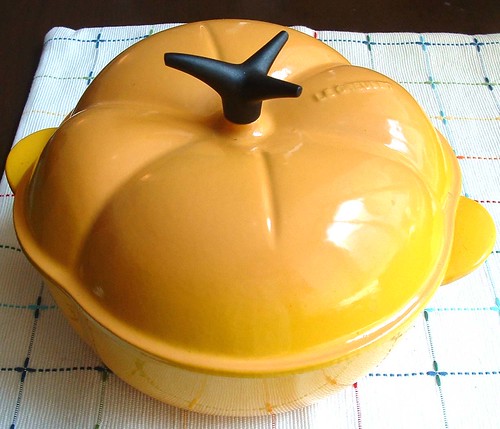
For someone who likes to cook and has been doing it for a while, I feel like I have a very poor understanding of cookware. Much of it stems from the fact that (a) I cook in a *tiny* kitchen with limited space for pots and pans, and (b) when I stocked my kitchen 5 years ago, I was under a tight budget and ended up getting one run-of-the-mill cookware set and then just using that for years. So I am starting to educate myself a little bit on cookware, and it turns out that cast-iron cookware is made by pouring molten iron into a mold (a centuries-old method of making cooking pots). The Le creuset variety is then coated with a layer of enamel, which means it does not require "seasoning" like regular cast iron pots do. The wonderful thing about cast iron pots is that they are nothing if not sturdy, so I totally expect to take good care of my little tomato and have it last a lifetime.
I searched around for a recipe to try in this pot, and came across one in a recent issue of Vegetarian Times magazine. It sounded like a delicious recipe (vegan to boot) and uses carrots (which I tend to under-use) and rubbed sage (a new addition to my spice rack). This recipe was part of an article on carrot recipes; I am dying to try out a carrot cake which was also published in the same article.
Tofu-Carrot Cacciatore
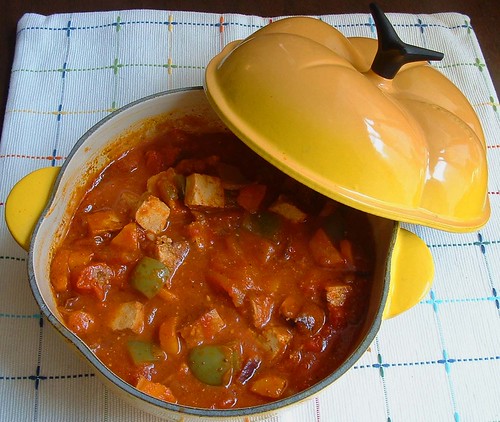
(adapted from "Vegetarian Times" magazine, serves 4-5)
Ingredients
1 bunch fresh carrots, peeled and cut into slices on a bias
1 green pepper, cut into large dice
1 onion, cut into large dice
2 cloves garlic, minced
1 8-oz package Italian-style baked tofu, cubed
1 28-oz can tomatoes (crushed or whole peeled)
1 tbsp olive oil
1 bayleaf
1 tbsp rubbed sage
salt and pepper to taste
1 and half cups dried pasta (your favorite shape)
Method
1. Heat the olive oil. Saute onions and garlic till transluscent and aromatic.
2. Add the carrots, peppers and bayleaf and saute for 3-4 minutes.
3. Add the tomatoes, sage, tofu, salt and pepper and simmer for 30-40 minutes.
4. Meanwhile, cook the pasta as per package directions. Serve the cacciatore over the hot pasta.
I was very impressed with the way this stew turned out. The le creuset casserole browns veggies just beautifully. It held heat for a really long time and was a snap to clean. Thanks, Laureen, I will be thinking of you every single time I use this beautiful pot!

For someone who likes to cook and has been doing it for a while, I feel like I have a very poor understanding of cookware. Much of it stems from the fact that (a) I cook in a *tiny* kitchen with limited space for pots and pans, and (b) when I stocked my kitchen 5 years ago, I was under a tight budget and ended up getting one run-of-the-mill cookware set and then just using that for years. So I am starting to educate myself a little bit on cookware, and it turns out that cast-iron cookware is made by pouring molten iron into a mold (a centuries-old method of making cooking pots). The Le creuset variety is then coated with a layer of enamel, which means it does not require "seasoning" like regular cast iron pots do. The wonderful thing about cast iron pots is that they are nothing if not sturdy, so I totally expect to take good care of my little tomato and have it last a lifetime.
I searched around for a recipe to try in this pot, and came across one in a recent issue of Vegetarian Times magazine. It sounded like a delicious recipe (vegan to boot) and uses carrots (which I tend to under-use) and rubbed sage (a new addition to my spice rack). This recipe was part of an article on carrot recipes; I am dying to try out a carrot cake which was also published in the same article.
Tofu-Carrot Cacciatore

(adapted from "Vegetarian Times" magazine, serves 4-5)
Ingredients
1 bunch fresh carrots, peeled and cut into slices on a bias
1 green pepper, cut into large dice
1 onion, cut into large dice
2 cloves garlic, minced
1 8-oz package Italian-style baked tofu, cubed
1 28-oz can tomatoes (crushed or whole peeled)
1 tbsp olive oil
1 bayleaf
1 tbsp rubbed sage
salt and pepper to taste
1 and half cups dried pasta (your favorite shape)
Method
1. Heat the olive oil. Saute onions and garlic till transluscent and aromatic.
2. Add the carrots, peppers and bayleaf and saute for 3-4 minutes.
3. Add the tomatoes, sage, tofu, salt and pepper and simmer for 30-40 minutes.
4. Meanwhile, cook the pasta as per package directions. Serve the cacciatore over the hot pasta.
I was very impressed with the way this stew turned out. The le creuset casserole browns veggies just beautifully. It held heat for a really long time and was a snap to clean. Thanks, Laureen, I will be thinking of you every single time I use this beautiful pot!
Saturday, July 08, 2006
Too Darned Hot: Mushroom Chettinad
When Barbara of Tigers and Strawberries announced that the theme this time around for her monthly "Spice is Right" event is It's too darned hot, with a focus on (what else but) chillies, I smiled to myself. Indian cuisine embraces its chillies, with nary a chilli-free savoury dish in sight.
Even so, some sub-cultures in India are famous for kicking up the heat to a whole 'nother level. For instance, Andhra cuisine uses chillies exuberantly (I once *wept* through a Andhra thali dinner at Bheema in Bangalore, and can't wait to go back for more), Kolhapuri cuisine is redolent with chillies and garlic (restaurants all over India serve what they call Kolhapuri-style dishes, the only common thread among these is lashings of chillies and garlic) and a relatively unknown cuisine known as Chettinad (from the Chettinad region of Tamil Nadu) that achieves its flavor from an intense combination of chillies and peppercorns.
My first taste of Chettinad food was in a rather unlikely location: a cafe adjoining a theatre in Bombay. At the time, I was living with my aunt Y (a regular reader of this blog) in Juhu, a swanky neighborhood in Bombay, and she gets all the credit for making me a culture vulture (to the modest extent that I am one, anyway). Y and I trooped over town to the theatre (both Marathi and English), museums, art galleries and fancy restaurants. We lived an envious life: we would shop till we dropped, snacking all the while, then come home and dine on pepsi and potato chips (this was a decade ago...now she has a kid to raise and I have a thesis to complete and that casually extravagant lifestyle seems nothing short of surreal). One of our favorite outings was a trip to the Prithvi Theatre to see the latest production, followed by a visit to the cafe for some snacks and the mandatory Irish coffee.
When I first tasted mushroom Chettinad at the Prithvi Cafe, it was a flavor explosion in my mouth. A burst of chillies and black pepper, mingling with the aroma of curry leaves and mustard seeds...I could not believe it! The taste was imprinted in my brain and has stayed with me for years. Traditional Chettinad cuisine, however, is very meat-oriented, and I never did get a chance to try my hand at making this dish. Until last week. I was reading The Turmeric Trail, a memoir-style cookbook by Raghavan Iyer (about the book: I liked the recipes but could not stand the prose) and came across a recipe for shrimp Chettinad. Just as I remembered, it called for a combination of peppercorns and chillies (a great deal of each), with a flavorful tempering of curry leaves and mustard seeds, counterbalanced with the tang of tamarind. I adapted the recipe to wild mushrooms bought fresh from the farmer's market, and the result was addictive, finger-licking good; but *very* hot, so you must sign a waiver if you want to try this recipe!
Mushroom Chettinad
(adapted from The Turmeric Trail by Raghavan Iyer; serves 2-3)
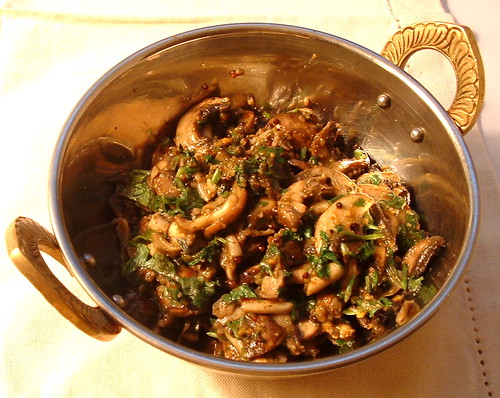
Ingredients
3 cups mixed wild mushrooms (I used cremini, shitake, oyster), cleaned and chopped coarsely
1 tsp tamarind paste
salt to taste
cilantro, minced, for garnish
For tempering
1 tbsp vegetable oil
1 tsp mustard seeds
5-6 fresh curry leaves
For spice mixture
1 tbsp split yellow peas (chana dal)
5-6 black peppercorns
2 dried red chillies
Method:
1. Roast all the ingredients for the spice mixture. Cool and grind in a spice/coffee grinder to a fine powder. Set aside.
2. Heat oil in a skillet. Add the mustard seeds and curry leaves and stir around for a few seconds till the seeds pop.
3. Saute the mushrooms in the tempered oil. Season with salt.
4. When the mushrooms start sweating, add the spice mixture and saute for a couple of minutes on low-medium heat.
5. Add the tamarind paste (and a few tablespoons of water if the mixture starts sticking to the pan). Stir for a minute.
6. Garnish with cilantro. Serve hot with rotis or rice.
Even so, some sub-cultures in India are famous for kicking up the heat to a whole 'nother level. For instance, Andhra cuisine uses chillies exuberantly (I once *wept* through a Andhra thali dinner at Bheema in Bangalore, and can't wait to go back for more), Kolhapuri cuisine is redolent with chillies and garlic (restaurants all over India serve what they call Kolhapuri-style dishes, the only common thread among these is lashings of chillies and garlic) and a relatively unknown cuisine known as Chettinad (from the Chettinad region of Tamil Nadu) that achieves its flavor from an intense combination of chillies and peppercorns.
My first taste of Chettinad food was in a rather unlikely location: a cafe adjoining a theatre in Bombay. At the time, I was living with my aunt Y (a regular reader of this blog) in Juhu, a swanky neighborhood in Bombay, and she gets all the credit for making me a culture vulture (to the modest extent that I am one, anyway). Y and I trooped over town to the theatre (both Marathi and English), museums, art galleries and fancy restaurants. We lived an envious life: we would shop till we dropped, snacking all the while, then come home and dine on pepsi and potato chips (this was a decade ago...now she has a kid to raise and I have a thesis to complete and that casually extravagant lifestyle seems nothing short of surreal). One of our favorite outings was a trip to the Prithvi Theatre to see the latest production, followed by a visit to the cafe for some snacks and the mandatory Irish coffee.
When I first tasted mushroom Chettinad at the Prithvi Cafe, it was a flavor explosion in my mouth. A burst of chillies and black pepper, mingling with the aroma of curry leaves and mustard seeds...I could not believe it! The taste was imprinted in my brain and has stayed with me for years. Traditional Chettinad cuisine, however, is very meat-oriented, and I never did get a chance to try my hand at making this dish. Until last week. I was reading The Turmeric Trail, a memoir-style cookbook by Raghavan Iyer (about the book: I liked the recipes but could not stand the prose) and came across a recipe for shrimp Chettinad. Just as I remembered, it called for a combination of peppercorns and chillies (a great deal of each), with a flavorful tempering of curry leaves and mustard seeds, counterbalanced with the tang of tamarind. I adapted the recipe to wild mushrooms bought fresh from the farmer's market, and the result was addictive, finger-licking good; but *very* hot, so you must sign a waiver if you want to try this recipe!
Mushroom Chettinad
(adapted from The Turmeric Trail by Raghavan Iyer; serves 2-3)

Ingredients
3 cups mixed wild mushrooms (I used cremini, shitake, oyster), cleaned and chopped coarsely
1 tsp tamarind paste
salt to taste
cilantro, minced, for garnish
For tempering
1 tbsp vegetable oil
1 tsp mustard seeds
5-6 fresh curry leaves
For spice mixture
1 tbsp split yellow peas (chana dal)
5-6 black peppercorns
2 dried red chillies
Method:
1. Roast all the ingredients for the spice mixture. Cool and grind in a spice/coffee grinder to a fine powder. Set aside.
2. Heat oil in a skillet. Add the mustard seeds and curry leaves and stir around for a few seconds till the seeds pop.
3. Saute the mushrooms in the tempered oil. Season with salt.
4. When the mushrooms start sweating, add the spice mixture and saute for a couple of minutes on low-medium heat.
5. Add the tamarind paste (and a few tablespoons of water if the mixture starts sticking to the pan). Stir for a minute.
6. Garnish with cilantro. Serve hot with rotis or rice.
Tuesday, July 04, 2006
Books and Food: A Tree Grows In Brooklyn by Betty Smith
This article is part of a special series called "Books and Food". I have loved books long before I ever got interested in the culinary arts. Short stories, novels, biographies and travelogues, I love them all. Human life is inextricably linked to food, and books often use descriptions of feasts and famines, dinner rituals and food memories to bring a point across to the reader. In this series, I talk about my favorite books and the food passages therein, and make a dish or a meal inspired by the book.
Today's book: A Tree Grows In Brooklyn by Betty Smith
The food: Breakfast strata

For the fourth of July, I chose an American classic. Betty Smith's "A tree grows in Brooklyn" is the story of a girl named Francie Nolan growing up in Brooklyn in the early 1900s. A fascinating portrait of life in an impoverished neighborhood, the story ends up so unexpectedly heartwarming and realistic that it stays with you long after you are done reading the book. Even during hard times, Francie's mother, Katie, stretches her resources to provide hot meals for her family. It is far too easy to go shopping and cook impressively on a big budget. The truly creative and resourceful cook is someone like Katie, working with the stale bread that is the staple of their diet:
"The Nolans practically lived on that stale bread amd what amazing things Katie could make from it! She'd take a loaf of stale bread, pour boiling water over it, work it up into a paste, flavor it with salt, pepper, thyme, minced onion and an egg (if eggs were cheap), and bake it in the oven. When it was good and brown, she made a sauce from half a cup of ketchup, two cups of boiling water, seasoning, a dash of strong coffee, thickened it with flour and poured it over the baked stuff. It was good, hot, tasty and staying. What was left over, was sliced thin the next day and fried in hot bacon fat.
Mama made a very fine bread pudding from slices of stale bread, sugar, cinnamon and a penny apple sliced thin. When this was baked brown, sugar was melted and poured over the top. Sometimes she made what she had named Weg Geschnissen, which laboriously translated meant something made with bread bits that usually would be thrown away. Bits of bread were dipped into a batter made from flour, water, salt and an egg and then fried in deep hot fat. While they were frying, Francie ran down to the candy store and bought a penny's worth of brown rock candy. This was crushed with a rolling pin and sprinkled on top of the fried bits just before eating. The crystals didn't quite melt and that made it wonderful"
In honor of every last crust of stale bread, I put together this breakfast strata. It is a fridge-cleaning "recipe", if you even want to call it a recipe. This is just a "Throw in whatever you got" kind of dish. I love making this on Saturday mornings to clean out the fridge before I head out to the Farmer's Market for my weekly groceries. It gets me off to a fresh start on weekends.
Breakfast Strata
(serves 2-3)
Ingredients:
3 eggs
Stale bread, cut into small cubes (about 2 cups)
Splash of milk or cream
Some sliced onions
Assorted veggies (peppers are good if you have any) (1 cup in all)
Assorted cheeses (shredded) (1/2 cup)
Salt and Pepper
Herbs (optional)
Method:
1. Saute the onions and veggies together. Set aside.
2. Beat the eggs together with cream/milk, salt and pepper.
3. Coat a gratin dish with non-stick spray. Layer with veggies, then bread cubes.
4. Pour the egg mixture over the bread cubes so that it soaks into the bread.
5. Top with the shredded cheese and herbs, if using.
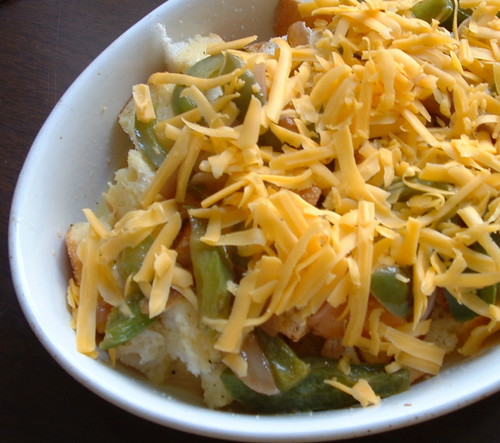
6. Bake at 350 degrees F for 15-20 minutes, till egg is cooked (knife should come clean) and cheese is golden.
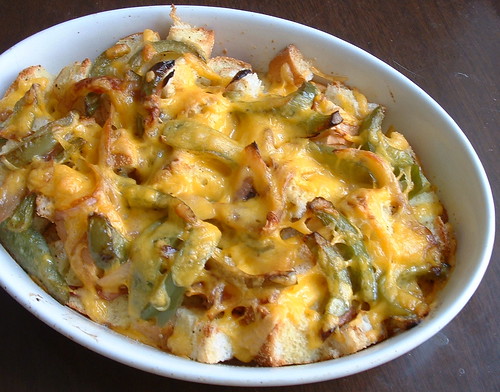
You never need to throw out any old bread: Stale Bread was the theme of a recent IMBB (food event) hosted by Derrick of An Obsession with Food. Read the round-ups here, here and here for a plethora of ideas on what to do with left-over bread. Another dish I love making with stale bread: Bread Pakoras!
Today's book: A Tree Grows In Brooklyn by Betty Smith
The food: Breakfast strata

For the fourth of July, I chose an American classic. Betty Smith's "A tree grows in Brooklyn" is the story of a girl named Francie Nolan growing up in Brooklyn in the early 1900s. A fascinating portrait of life in an impoverished neighborhood, the story ends up so unexpectedly heartwarming and realistic that it stays with you long after you are done reading the book. Even during hard times, Francie's mother, Katie, stretches her resources to provide hot meals for her family. It is far too easy to go shopping and cook impressively on a big budget. The truly creative and resourceful cook is someone like Katie, working with the stale bread that is the staple of their diet:
"The Nolans practically lived on that stale bread amd what amazing things Katie could make from it! She'd take a loaf of stale bread, pour boiling water over it, work it up into a paste, flavor it with salt, pepper, thyme, minced onion and an egg (if eggs were cheap), and bake it in the oven. When it was good and brown, she made a sauce from half a cup of ketchup, two cups of boiling water, seasoning, a dash of strong coffee, thickened it with flour and poured it over the baked stuff. It was good, hot, tasty and staying. What was left over, was sliced thin the next day and fried in hot bacon fat.
Mama made a very fine bread pudding from slices of stale bread, sugar, cinnamon and a penny apple sliced thin. When this was baked brown, sugar was melted and poured over the top. Sometimes she made what she had named Weg Geschnissen, which laboriously translated meant something made with bread bits that usually would be thrown away. Bits of bread were dipped into a batter made from flour, water, salt and an egg and then fried in deep hot fat. While they were frying, Francie ran down to the candy store and bought a penny's worth of brown rock candy. This was crushed with a rolling pin and sprinkled on top of the fried bits just before eating. The crystals didn't quite melt and that made it wonderful"
In honor of every last crust of stale bread, I put together this breakfast strata. It is a fridge-cleaning "recipe", if you even want to call it a recipe. This is just a "Throw in whatever you got" kind of dish. I love making this on Saturday mornings to clean out the fridge before I head out to the Farmer's Market for my weekly groceries. It gets me off to a fresh start on weekends.
Breakfast Strata
(serves 2-3)
Ingredients:
3 eggs
Stale bread, cut into small cubes (about 2 cups)
Splash of milk or cream
Some sliced onions
Assorted veggies (peppers are good if you have any) (1 cup in all)
Assorted cheeses (shredded) (1/2 cup)
Salt and Pepper
Herbs (optional)
Method:
1. Saute the onions and veggies together. Set aside.
2. Beat the eggs together with cream/milk, salt and pepper.
3. Coat a gratin dish with non-stick spray. Layer with veggies, then bread cubes.
4. Pour the egg mixture over the bread cubes so that it soaks into the bread.
5. Top with the shredded cheese and herbs, if using.

6. Bake at 350 degrees F for 15-20 minutes, till egg is cooked (knife should come clean) and cheese is golden.

You never need to throw out any old bread: Stale Bread was the theme of a recent IMBB (food event) hosted by Derrick of An Obsession with Food. Read the round-ups here, here and here for a plethora of ideas on what to do with left-over bread. Another dish I love making with stale bread: Bread Pakoras!
Saturday, July 01, 2006
Weekend Dog Blogging

Dale shows off his brand new blue leash - a gift from V's Dad. Dale is a happy puppy these days: I made a trip to the Three Dog Bakery near Pike Place Market in Seattle and came back with these treats for Dale:

Go visit Sweetnicks, where it is puppy-central every weekend!
